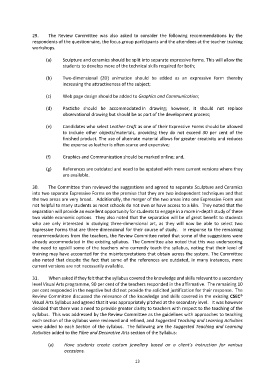Page 1385 - SUBSEC October 2017_Neat
P. 1385
29. The Review Committee was also asked to consider the following recommendations by the
respondents of the questionnaire, the focus group participants and the attendees at the teacher training
workshops.
(a) Sculpture and ceramics should be split into separate expressive forms. This will allow the
students to develop more of the technical skills required for both;
(b) Two-dimensional (2D) animation should be added as an expressive form thereby
increasing the attractiveness of the subject;
(c) Web page design should be added to Graphics and Communication;
(d) Pastiche should be accommodated in drawing; however, it should not replace
observational drawing but should be as part of the development process;
(e) Candidates who select Leather Craft as one of their Expressive Forms should be allowed
to include other objects/materials, providing they do not exceed 30 per cent of the
finished product. The use of alternate material allows for greater creativity and reduces
the expense as leather is often scarce and expensive;
(f) Graphics and Communication should be marked online; and,
(g) References are outdated and need to be updated with more current versions where they
are available.
30. The Committee then reviewed the suggestions and agreed to separate Sculpture and Ceramics
into two separate Expressive Forms on the premise that they are two independent techniques and that
the two areas are very broad. Additionally, the merger of the two areas into one Expressive Form was
not helpful to many students as most schools do not own or have access to a kiln. They noted that the
separation will provide an excellent opportunity for students to engage in a more in-depth study of these
two viable economic options. They also noted that the separation will be of great benefit to students
who are only interested in studying three-dimensional art, as they will now be able to select two
Expressive Forms that are three-dimensional for their course of study. In response to the remaining
recommendations from the teachers, the Review Committee noted that some of the suggestions were
already accommodated in the existing syllabus. The Committee also noted that this was underscoring
the need to upskill some of the teachers who currently teach the syllabus, noting that their level of
training may have accounted for the misinterpretations that obtain across the system. The Committee
also noted that despite the fact that some of the references are outdated, in many instances, more
current versions are not necessarily available.
31. When asked if they felt that the syllabus covered the knowledge and skills relevant to a secondary
level Visual Arts programme, 90 per cent of the teachers responded in the affirmative. The remaining 10
per cent responded in the negative but did not provide the solicited justification for their response. The
Review Committee discussed the relevance of the knowledge and skills covered in the existing CSEC®
Visual Arts Syllabus and agreed that it was appropriately pitched at the secondary level. It was however
decided that there was a need to provide greater clarity to teachers with respect to the teaching of the
syllabus. This was addressed by the Review Committee as the guidelines with approaches to teaching
each section of the syllabus were reviewed and refined, and Suggested Teaching and Learning Activities
were added to each Section of the syllabus. The following are the Suggested Teaching and Learning
Activities added to the Fibre and Decorative Arts section of the Syllabus:
(a) Have students create custom jewellery based on a client’s instruction for various
occasions.
13

